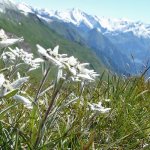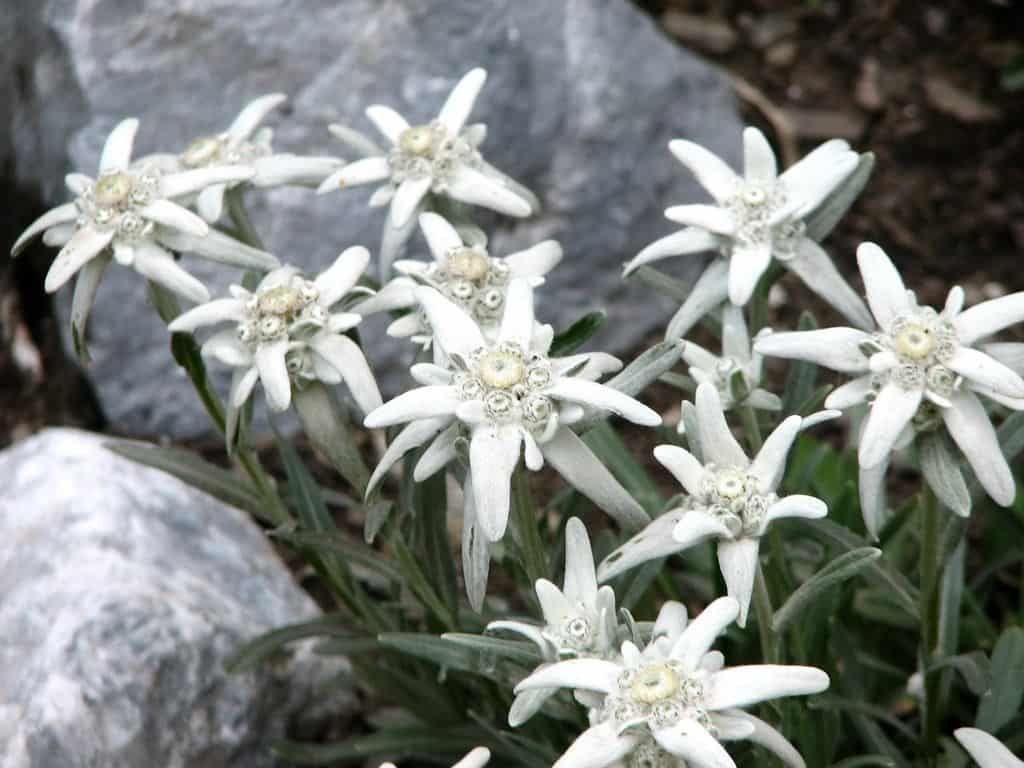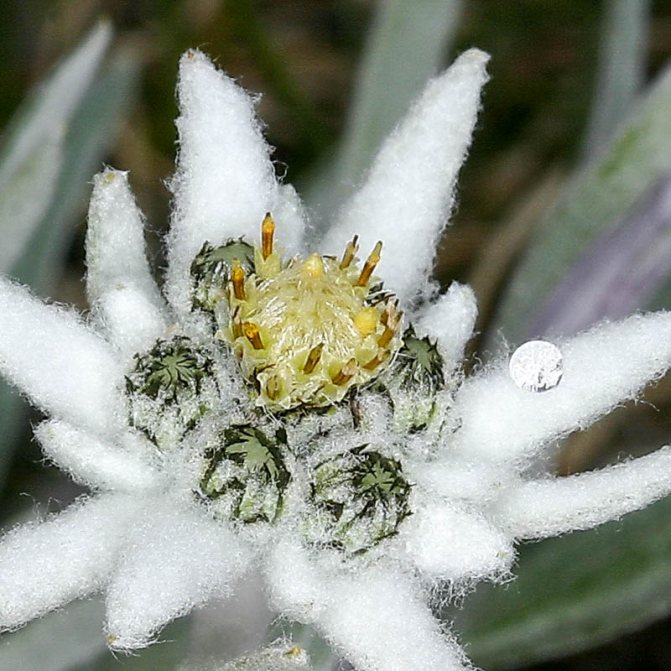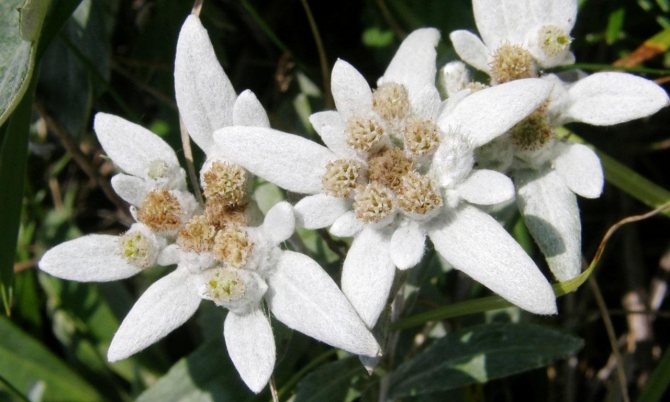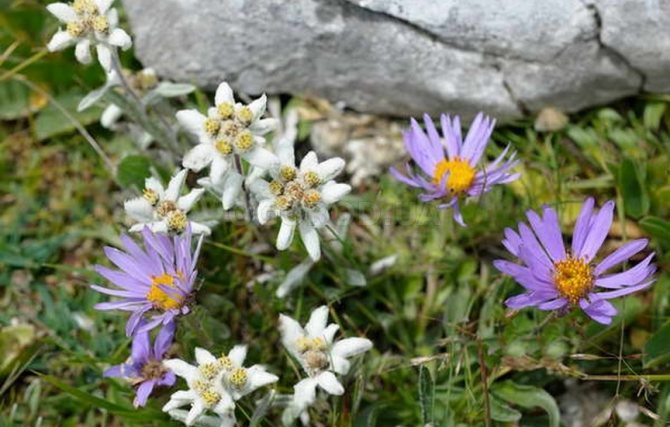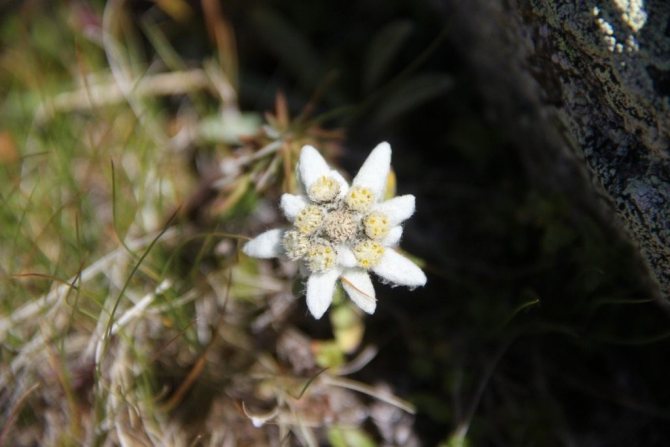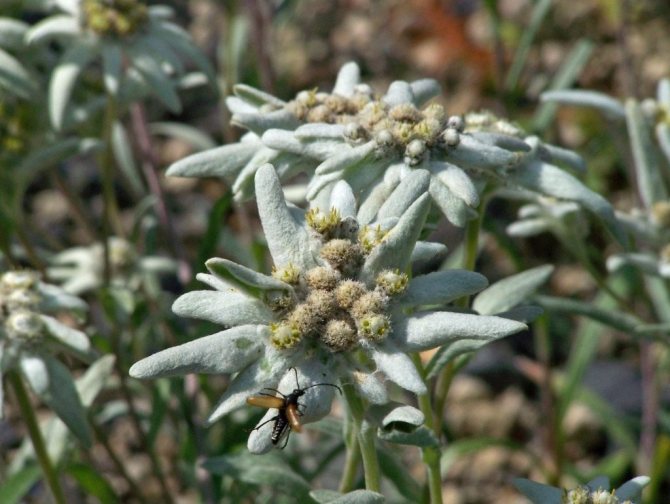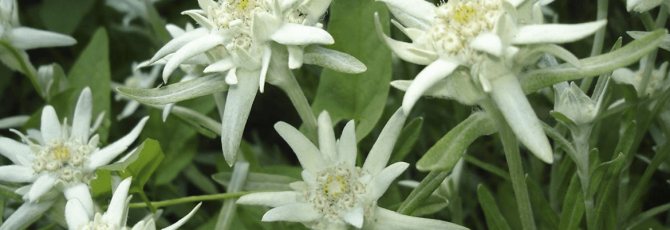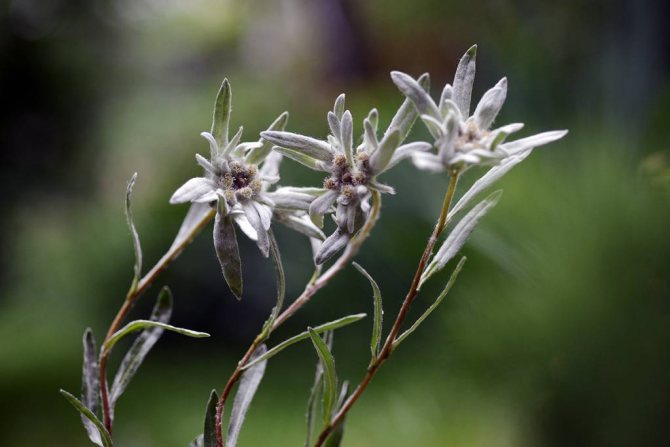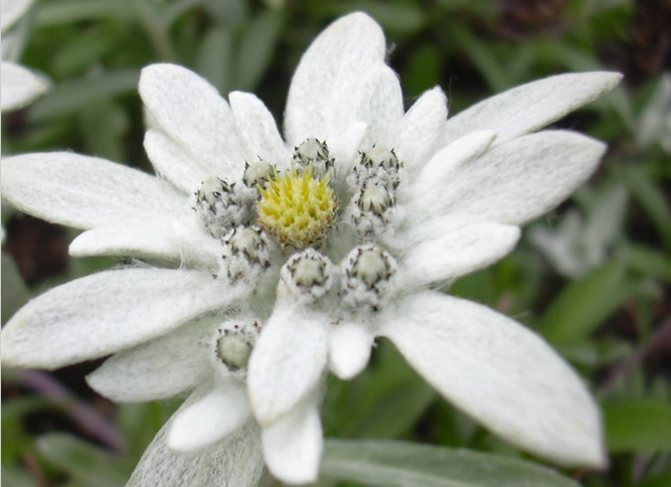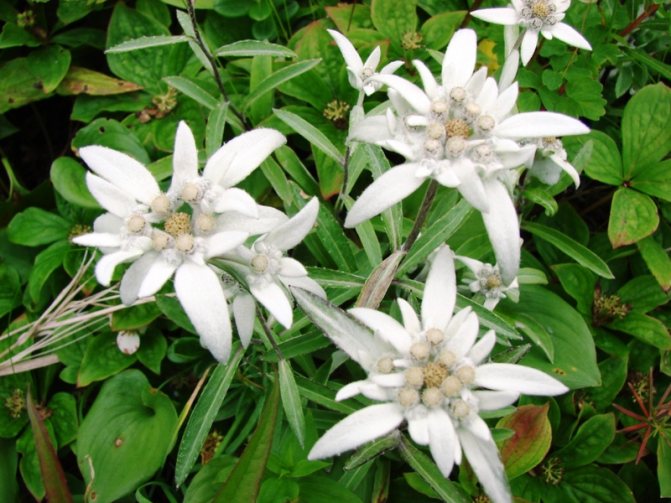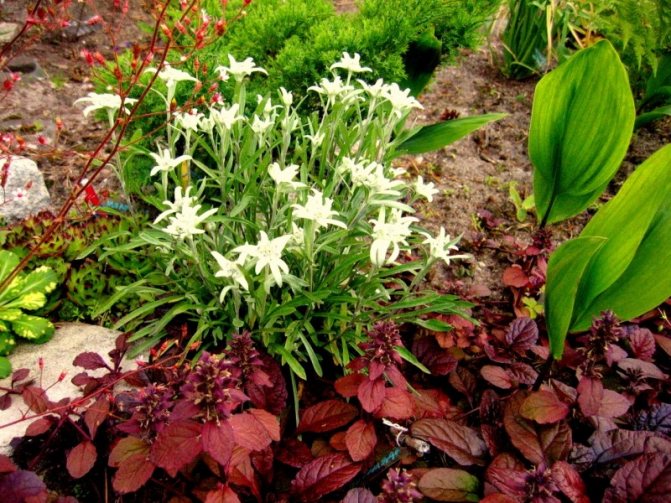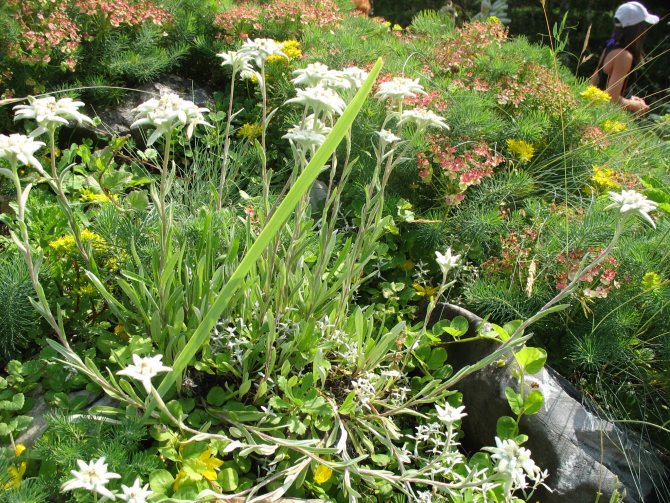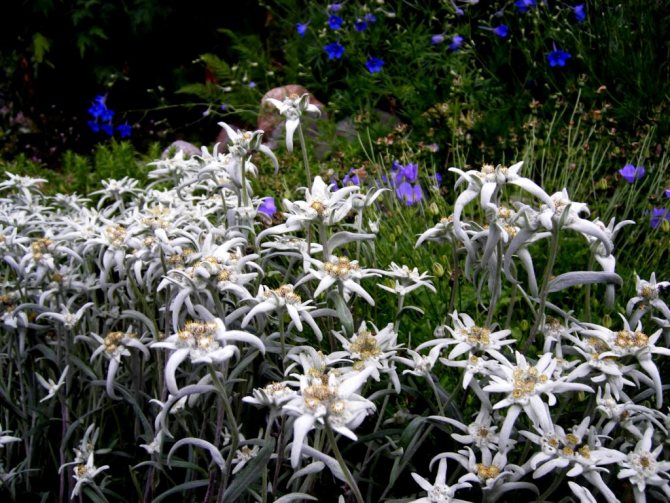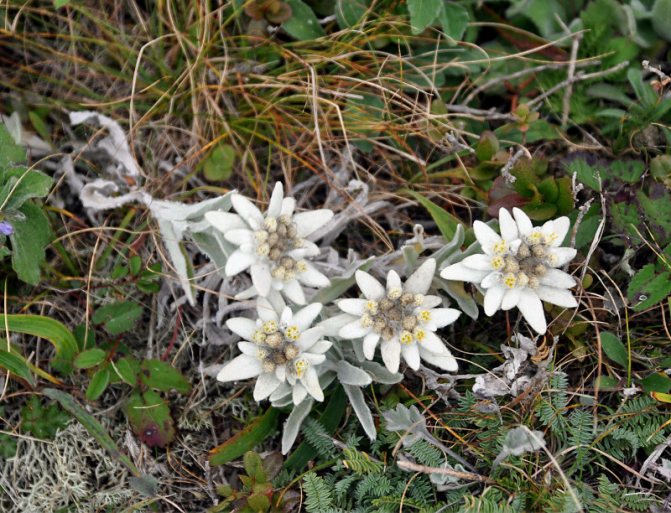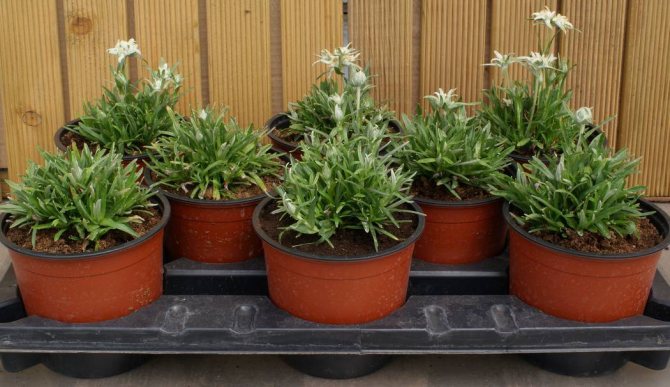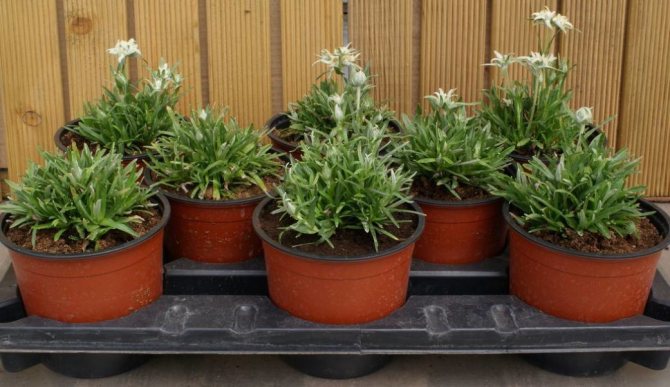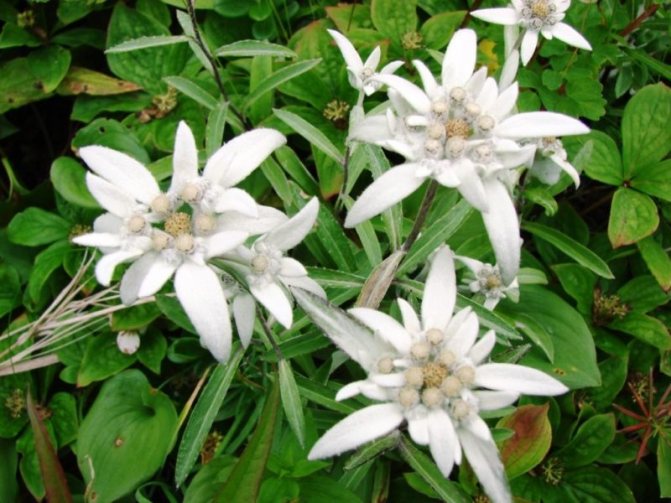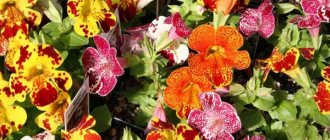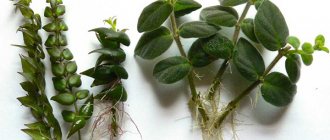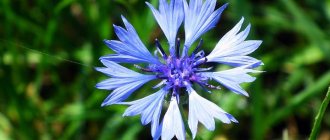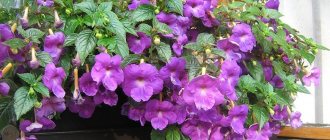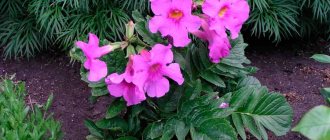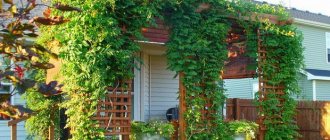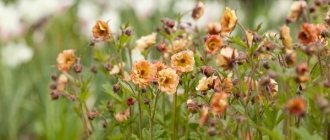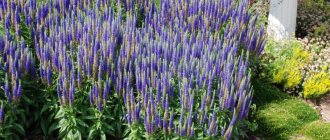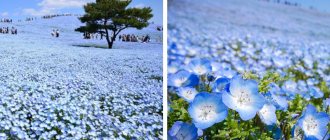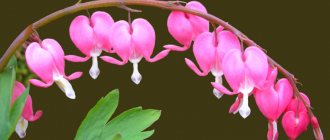Edelweiss (Leontopodium) or leontopodium is a genus of herbaceous plant of the Aster family.
Edelweiss is a word of German origin, meaning "noble white". The flower is shrouded in numerous legends about romantic love, secrets, it is considered a symbol of loyalty and devotion.
This small, beautiful flower is shrouded in many secrets. Even in ancient times, he was considered a symbol of loyalty, love and courage... Men, risking their lives, procured this flower for their beloved high in the mountains.
In nature, the plant grows among rocks, rock fragments. More often found in the Far East, as well as in the mountainous regions of the Himalayas, Carpathians, Tibet. Loves the burning rays of the sun.
Features of Edelweiss
The history of the plant is very beautiful. It is about courage and love, and the flower itself, according to one of the legends, appeared on the slopes of the mountains from the tears with which the girl cried, yearning for her beloved. It is believed that if a man finds Edelweiss in the mountains and gives it to a woman, then he truly loves her.
Where does Edelweiss grow in the wild?
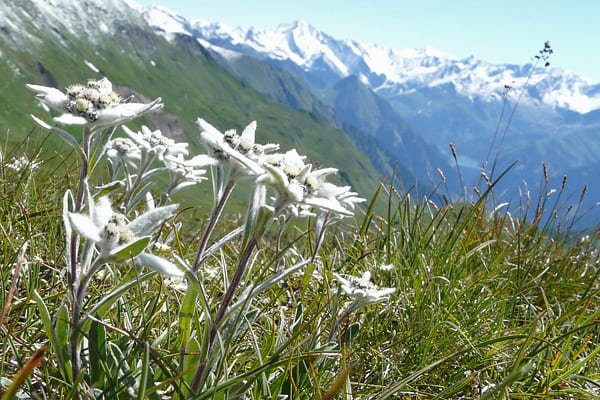
- In the wild, flowers grow among rocks in the mountains at a level of 1,800-2,000 km above sea level. The area of growth is the subalpine and alpine belt, more often you can find in the Carpathians and the Alps, as well as in Tibet and in the Himalayas.
- There is also such a variety as Edelweiss Palibina, which can be found in Siberia, Mongolia and Korea. There, it is also distributed only in mountainous areas. This plant is slightly larger in size than Alpine Edelweiss.
- The flowering period begins in early summer and lasts until August. Small white flowers look great in rocky areas, where there is little vegetation, and especially flowering specimens.
Botanical description
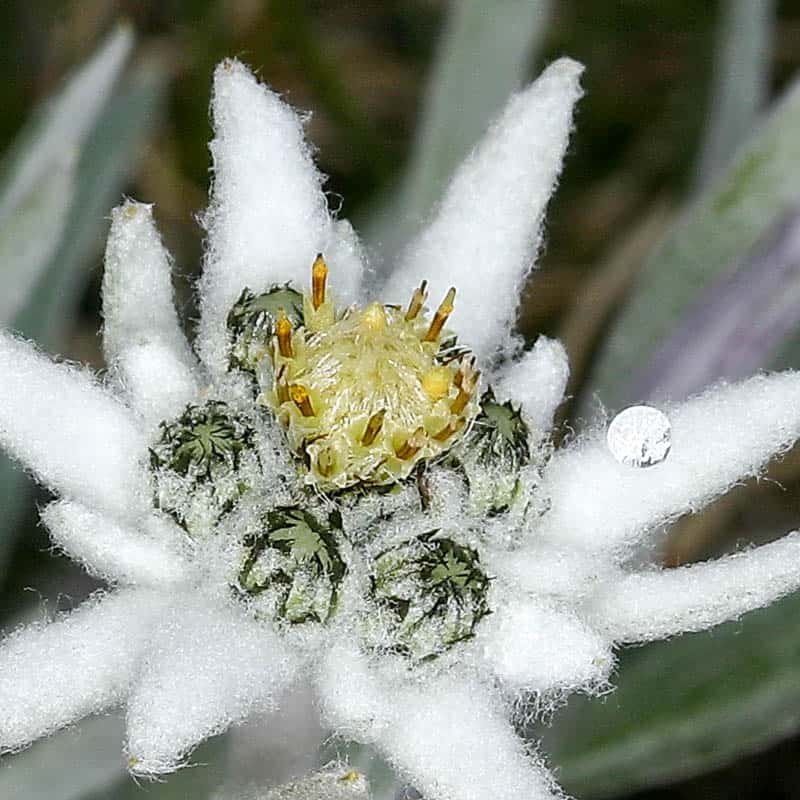

- Edelweiss can be an annual or perennial, dicotyledonous, belongs to the Asteraceae (Compositae) family. The plant is distinguished by its endurance and reaches a height of 25 - 30 cm, and a width of 15 - 22 cm.
- Since it is located high in the mountains, where the humidity level is high, the leaves and stems are covered with a grayish tomentose pubescence, which protects the flower from excessive moisture evaporation.
- The flowers are mostly pure white. The inflorescences are collected in baskets, differing in density. They are connected into heads. The structure of the inflorescence is quite strong and firm, as there are high winds in the rocky area.
- The leaves, which are collected at the very top of the flower, form an asterisk. Because of this, the French call Edelweiss "the Alpine star".
- Another name Leontopodium, translated from Greek means "lion" and "leg", is a more scientific definition. It happened because the shape of the flower is like a lion's paw. The very name "Edelweiss" is translated as "noble" and "white" (transliteration from German).
- The stems on which the flowers bloom emerge from a rosette of leaves lying on the ground. The rosette is lanceolate. The leaves are dark green in the upper part, and almost white and pubescent in the lower.
- It is the presence of villi that allows Edelweiss to endure severe winters, being in mountain gorges, even with a small amount of snow. The plant is not afraid of the sun, on the contrary, it attracts its leaves and flowers to it.
- If the conditions are favorable, then at the end of flowering a cylindrical achene is formed, where a large number of fluffy seeds - "parachutes" are located.
Often these hardy and strong flowers are called "molds" because of the fluffy coverage of stems and leaves. In total, today there are about 40 types of Edelweiss. However, if you want to grow a flower in a hot climate or in a place where there is too much humidity, then this is unlikely to work, since under such conditions Edelweiss does not grow.
Edelweiss - growing in the garden
Edelweiss is a herb from the Asteraceae family. From German, the name of the flower is translated as noble white. The plant also has a botanical "name" - leontopodium. It comes from a combination of the Greek words "lion" and "paw", since the edelweiss inflorescences resemble a lion's paw. In nature, the plant is found on rocks and approaches to snow-capped peaks. In France, edelweiss was dubbed the alpine star, and in Italy the silver flower of the rocks.
More about the flower
The enormous popularity of edelweiss is due to the many legends telling about its origin, in which they praised courage, bravery, and love. The inaccessibility of the flower made it a symbol of love, therefore, in natural conditions, it is almost on the verge of extinction. Edelweiss does not differ in external decorativeness. They grow no higher than 30 cm, bloom in medium-sized inflorescences in the summer, but they look so original and unusual that they immediately attract attention.
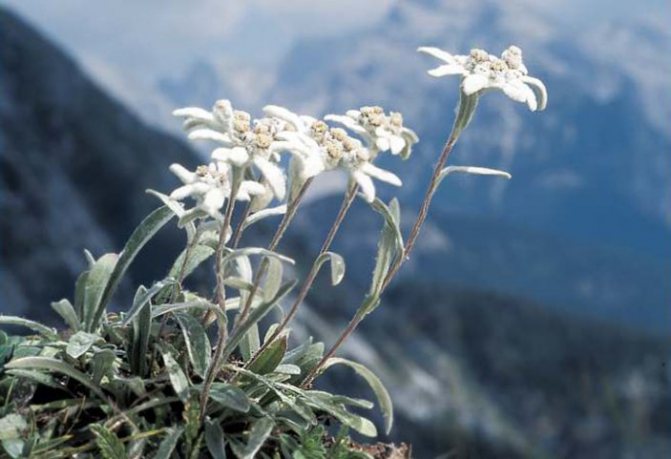

Flower care
Edelweiss is quite whimsical in terms of keeping conditions, but with a little effort, the flower will become a wonderful decoration of the garden.
Lighting
It is preferable to plant edelweiss in a well-lit area where water does not stagnate. The ideal option would be a small hill. The flower also feels great when it is illuminated by the sun before lunchtime, and the rest of the day is in light partial shade. Edelweiss should not be planted in lowlands and depressions.
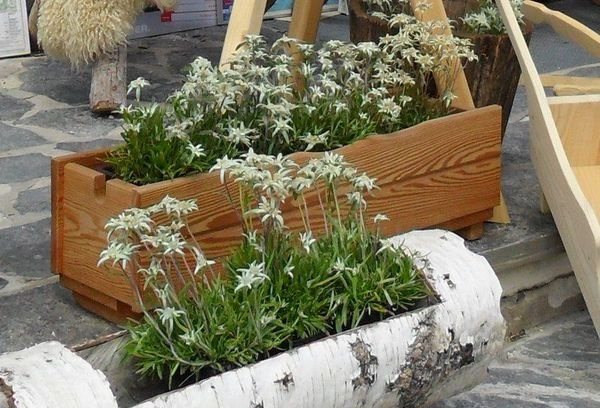

Temperature
In nature, edelweiss grows in areas with sharp changes in day and night temperatures, but they do not tolerate extreme heat rather poorly. If summer is really extreme in the region, plant a flower where there is partial shade in the afternoon. For the winter, young specimens are covered with straw or fallen leaves, which are harvested in early spring.
Humidity
This decorative and flowering garden culture does not tolerate high humidity. It is not recommended to plant edelweiss near natural or artificial reservoirs.
Watering
An excess and stagnation of moisture in the soil leads to the death of the flower. Edelweiss should be watered sparingly and only in severe drought conditions. It is always necessary to focus on the state of the earthen coma. If it rains, the plant is not watered for three to four weeks. When precipitation falls constantly, it is better to cover the plant with a film.
Priming
The flower requires dry, light, permeable, lime-rich soil. It does not grow on fertile soils, but requires a depleted substrate, consisting mostly of coarse sand. The latter can be added at the time of planting the edelweiss. It is allowed to replace sand with crushed stone.
Circumcision
Edelweiss do not belong to large horticultural crops and do not require the formation of a bush. No pinching or pruning. Of course, you can experiment, but this will not have any big effect on the decorativeness of the flower.
Top dressing
The plant reacts extremely negatively to organic and mineral fertilizers. The greatest danger to edelweiss is humus. A little feeding is allowed only to restore the flower if it is frozen.
Transfer
Edelweiss, growing in one place for a long time, lose their decorative effect, therefore, they need to be transplanted every three years. The flower has long roots, so new holes are made deep. The plant is carefully dug up, the roots are straightened, lowered into a hole and sprinkled with dry soil. When all specimens are transplanted, abundant watering is performed. If the edelweiss have taken root, side stems appear on the bush, which means that they will bloom the next year.
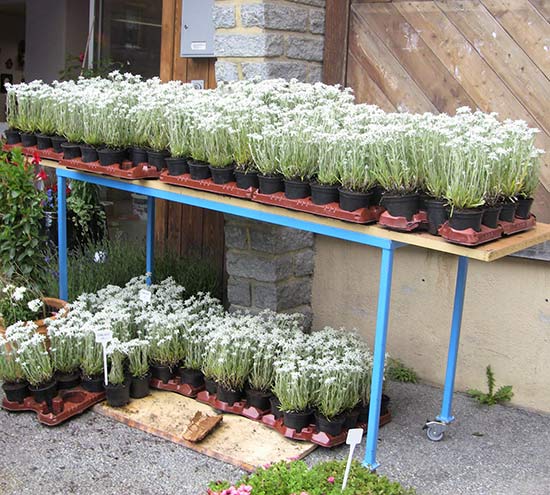

Reproduction
When the flower is already growing in the garden, it is best to propagate it vegetatively. In other cases, they resort to obtaining seedlings from seeds. The latter method is quite laborious to implement, it does not always allow preserving species characteristics, but it is the only one if there is no adult specimen. Seeds can be sown in early spring right in the garden, but this approach is not always justified, since it does not guarantee germination. In addition, edelweiss can start to grow erratically, which will minimize the decorative effect of planting. It is best to transplant ready-made seedlings into the garden, grown from seeds in a mixture of sand and leafy earth, taken in a 1: 2 ratio. It is recommended to pre-mix the planting material with moist soil and place it in the refrigerator for 3 weeks. Top of the planting is covered with glass jars and kept at a temperature of +15 degrees Celsius. Shoots appear in about two weeks. They are so small that watering is carried out with a spray gun, spraying moisture at a distance of 20 cm from the plantings, but only when the soil in the containers becomes dry. Seedlings are planted in open ground in early June. Edelweiss grown from seeds bloom in the second or third year. The flower is propagated vegetatively by cuttings and dividing the bush. Shoots from adult edelweiss are best planted in June. The tops from last year's shoots are cut from the plant. They are planted in sand and leafy soil with the addition of lime. The main thing is to maintain a distance of 15 cm between plantings. The division of the bushes can be carried out almost the entire season.
Diseases and pests of edelweiss
The flower is considered one of the most resistant to almost any pest, and it rarely gets sick, but it also has natural enemies.
Diseases
Edelweiss is afraid only of stagnant water in the soil. Waterlogging of the soil leads to decay of the root system. A flower can be saved either by an artificially created drought, which is almost impossible to achieve, or by transplanting it into dry soil, which is also problematic. It is much easier to simply not flood the plant and cover it during the rainy season.
Pests
The only parasitic insect against which edelweiss is defenseless is aphid. To get rid of the pest, the plant is treated with insecticides. Folk methods against aphids, if it affects edelweiss, are powerless.
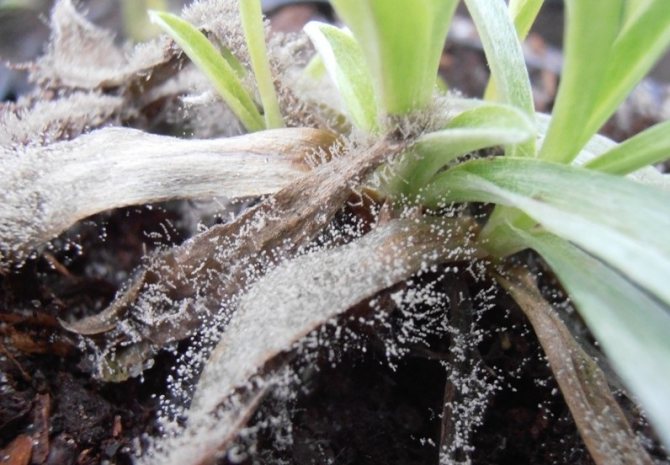

Edelweiss varieties for garden cultivation
In garden culture, the following varieties of edelweiss are most widespread:
- Alpine. It grows up to 20 cm, has apical double leaves that form a kind of star with many rays. The flowering period is in the summer months.
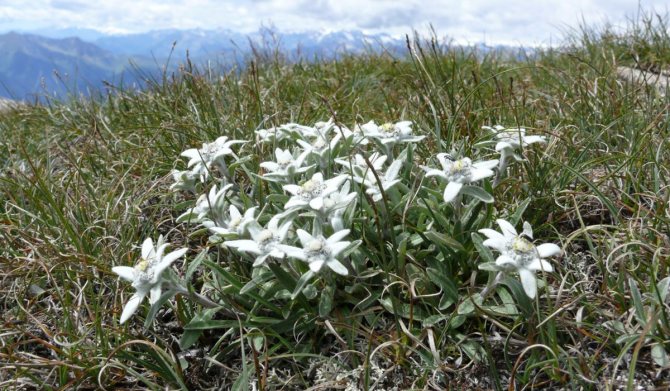

- Siberian. A close relative of the Alpine edelweiss.
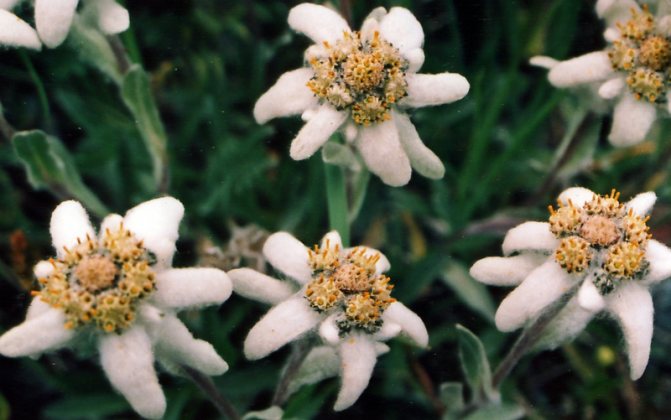

- Pale yellow. The plant has yellow-greenish lanceolate bracts oblong leaves that have curled edges, and single stems often go bald as they grow.
- Edelweiss-like. A tall representative of edelweiss, whose stem reaches 35 cm. The leaves are pointed, linear. Their color is close to a grayish tomentose shade.
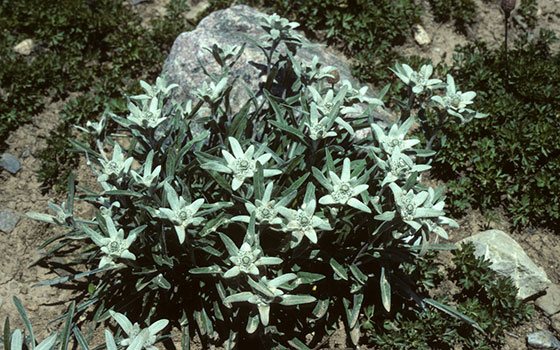

- Kurilskiy. It does not grow more than 20 cm. It has straight stems, and narrow-lanceolate leaves, almost the same in length to each other, form a semblance of a star. They are pubescent on both sides.
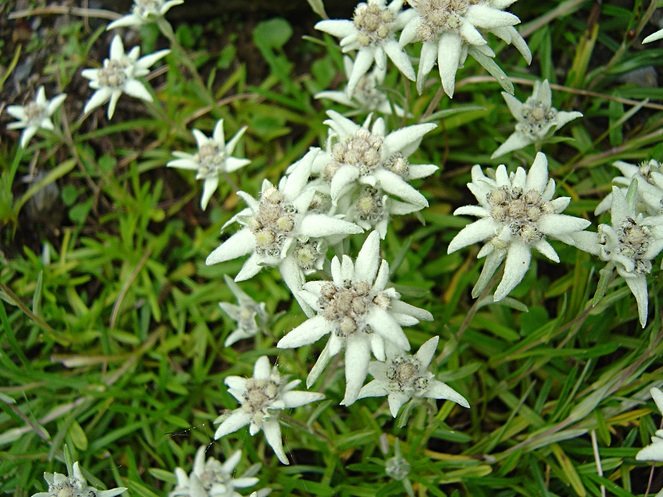

There are other varieties of edelweiss, but these are the ones that best take root in the garden.
Questions and answers
- Can Edelweiss be grown in hot and humid regions? No, this culture will not grow where there is no cool weather and the air is too humid.
- Are the edelweiss bracts starting to lose their prolapse? The reason for this is lack of calcium. If there is not enough lime in the soil, the flower will simply die, so it is imperative to correct the composition of the soil.
- Where do edelweiss look best in the garden? This flower is not recommended to be combined with beautifully blooming tall flowers. It looks great in rocky gardens, on alpine slides, and also in isolation. Beautiful edelweiss look like single plantings next to coniferous bushes and trees.
Edelweiss, a flower that is traditionally considered an exotic, mountainous plant, can be grown without much difficulty in an ordinary garden flower garden. And the alpine slides that have become popular, without edelweiss, are not alpine at all.
Almost everyone has heard about edelweiss, but few people know that there are several species of this flower.
Alpine edelweiss is the most common species. But in addition to it, there is also the Kuril edelweiss, and e. Siberian, and e. pale yellow, and even a species with a strange name "edelweiss edelweiss". The differences between these species are insignificant, and the growing conditions and care requirements are exactly the same. Therefore, the choice will depend only on your preferences and the availability of seeds of one kind or another.
Main types
Consider several varieties that can be found not high in the mountains, but in personal plots along garden paths or on alpine slides.
Alpine
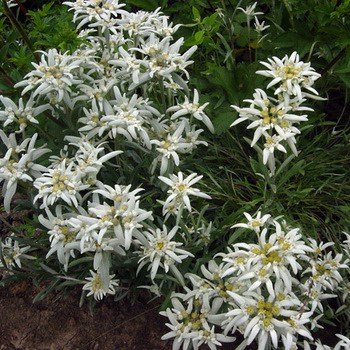

This species is listed in the Red Book, is popular and loved by flower growers for its resistance to a harsh climate, cold weather and drought.
- The plant, like all representatives of this plant, does not tolerate moisture, shade and excessive fertilization. Prefers stony drainage soil, grows even on poor soil.
- Leafy stems, all parts of the plant, except flowers, are covered with villi. The flowers are light yellow in color, the stipules are white with a silvery coating.
- The flower grows for a very long time until a curtain is formed. It is undesirable to plant next to garden plants that are endowed with too much branched and aggressive root system.
- Looks very nice in the vicinity of various conifers of dwarf varieties or plants in which the main decoration is foliage.
Bicolor
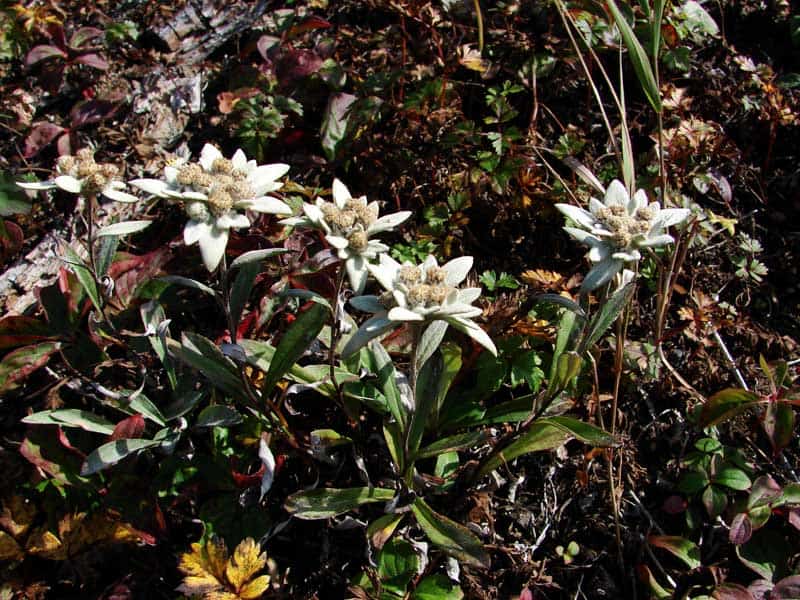

- This species grows in the Far East. The height of the bush is 30 - 35 cm.
- The leaves of the rosette are whitish in color due to pubescence.
- The bracts are characterized by petals, the length of which is different. The main difference from the Alpine Edelweiss in the flower diameter is only 3.5 - 4 cm. At the top of the flower are petals in the shape of a star.
- The flowering period begins in mid-summer and the flowers remain fresh and decorative throughout the season.
Seeds of this plant can now be purchased at any flower shop. Experienced florists recommend planting a plant before winter. Then in the spring, after the establishment of heat, the first shoots appear.
Kuril
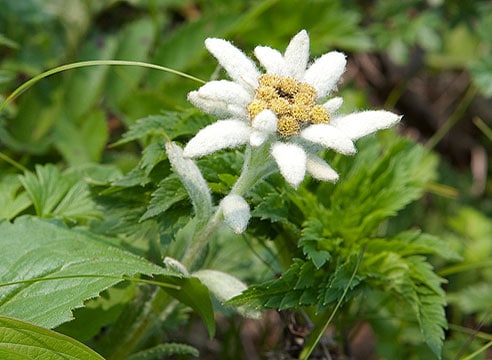

- The height of the plant is only 15 cm, but the diameter of the flowers is 4 - 5 cm.
- The stipules contain more than 10 petals, which are covered with whitish felt down.
- Like the rest of the species, this one blooms in mid-summer and blooms until early fall. In September, a seed box is formed.
- The stems and leaf plates seem to be covered with cobwebs, which makes the flower very interesting and decorative. It is recommended to plant it in rocky gardens and rock gardens.
External description of the flower
Even an amateur gardener knows what an edelweiss flower looks like. It is a low-growing herb with beige-white flowers and beautiful foliage. Average height up to 35 cm, width - 22. White bracts, framed with yellow edging, reaches 10 cm in diameter. Blossoms of inflorescences are collected in dense heads.Edelweiss gradually expands as it grows thanks to self-seeding and creeping underground rhizomes.
It grows well from both seeds and earthen roots. The flowers are softly pubescent and stand out against the green-silvery foliage. The Latin name was given to the plant for its external resemblance to the paw of a lion.
The alpine flower looks great against the curbs. Blooming in late summer, edelweiss will delight the owner until the end of autumn. Then the dried inflorescences will be able to decorate festive winter bouquets.
Landing features
The most convenient way is to seed the plant. Before planting, the seeds must be poured into a plastic bag and placed in a cold place for 14 to 20 days. So they will be tempered, and they will go through the process of stratification.
Growing seedlings
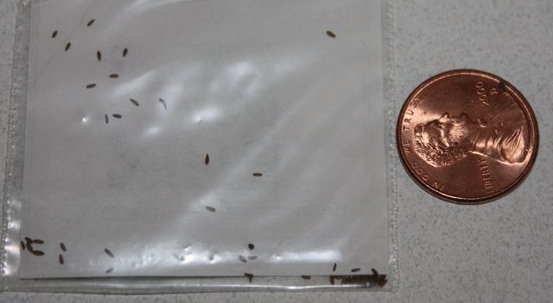

- Start the procedure in the last decade of February or early March. Prepare a seed nutrient mixture: Mix 1 part garden soil, 1 part deciduous soil, 1 part perlite, and 1 part sand. The soil should not only be fertile, but loose and light.
- Lay the planting material on a layer of earth with a certain distance. Press gently on top with your palm.
- Then moisten the substrate with a spray bottle evenly, but not too much to prevent the seeds from sinking deep into the soil.
- Create a greenhouse effect by covering the top of the container (you can use a container) with film or glass. The room temperature should be no more than +10 degrees.
- As soon as the seeds hatch, remove the cover and move the box to a place where it is warm and full of sun.
- A feature of this plant is a fairly long growth. When the seedlings stretch to a height of several centimeters, they must be placed in separate pots. Plastic cups are also fine.
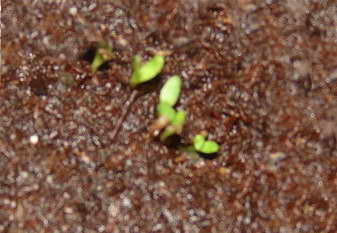

In the second half of April and until the second decade of May, plants are planted in open soil, making a gap between seedlings of at least 15 - 18 cm.
Planting seeds directly into open ground
When Edelweiss is in natural conditions, the seeds, after flowering and ripening, are carried by the wind throughout the mountainous area. The flower can germinate even in the absence of fertile soil, among the stones.
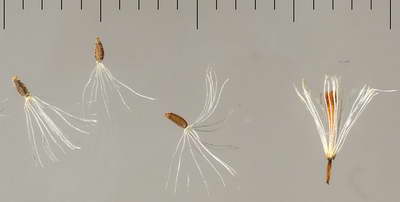

- It is possible not to grow seedlings at all, but immediately at the end of spring, plant Edelweiss in a pre-prepared place in the fresh air. Wait until the residual night frost is completely gone.
- Deepen the seed 1 -2 cm into the soil, try to maintain a distance, but you still have to thin out the planting later. The permissible distance between shoots is no more than 8 cm.
- When the flowers germinate more, gain strength, plant them at intervals of 15 - 20 cm.
Seedlings appear in about 6 to 8 weeks. However, under suitable conditions, you can see the first shoots within 7 to 10 days.
Reproduction by dividing the bush
This method is used less often as it is important not to damage the plant's root system. The procedure every few years is mandatory for Edelweiss.
- Prepare the inventory to be disinfected in advance. A sharp knife or garden tool is suitable for this method.
- Dig out the bush, carefully free it from the old earth. Cut the queen cell into several parts so that each has at least one growth point. The distance between the seedlings should be 20 - 30 cm.
Planting and breeding edelweiss
The most reliable way to plant edelweiss is by seedlings. The timing of sowing seeds for seedlings is traditional - February - March. The technology of planting and growing edelweiss seedlings practically does not differ from growing seedlings of annual garden flowers and vegetables. To enhance germination, edelweiss seeds can be pre-prepared. That is, subject them to stratification over the course of a month. It will be most convenient to mix edelweiss seeds with coarse sand or (even better) with perlite, and spread evenly over the entire surface of the planting soil mixture without embedding them in the ground.As a soil, the usual universal mixture is suitable. Then everything is as with ordinary seedlings, cover the container with glass or film, moisten, ventilate, etc. You may have to wait for seedlings for a long time, a month, or even two. But it is not uncommon for edelweiss shoots to hatch after a couple of weeks. With their appearance, the film (glass) can be removed. When stable warm weather is established, and in most cases this is the month of May, seedlings of edelweiss can be planted.
At the same time, you can sow edelweiss seeds directly into the open ground, if you prefer this planting method.
Over time, when the flowers grow well, the bushes can be separated. But keep in mind - edelweiss is a very sensitive flower, and it must be divided with the utmost care and accuracy.
Care
Soil for Edelweiss should be light and drained, preferably limestone, with a neutral acidity level. There should be plenty of sun and moderate watering.
The flower winters well under the snow. If the winter is not snowy, then make a layer of mulch, which needs to be removed in the spring. Spring frosts are not terrible for Edelweiss.
The bush needs to be divided every 3 years, thus the plant rejuvenates. Of the fertilizers, only mineral fertilizers are suitable, which are applied in spring.
Growing and caring for edelweiss
Location and soil requirements
Although under natural conditions edelweiss most often grows in the sunniest places, in home growing it is best to plant it in light partial shade. The main requirement for the site is that it should not be in the lowlands where moisture accumulates! The soil on the site should be poor, with a minimum content of nutrients.
Important! Edelweiss cannot be fed. Fertilizers of any kind can kill a flower.
At the same time, the land must be very good at letting moisture through, preventing stagnation of water. It is highly desirable to create conditions for edelweiss as close as possible to natural ones. Add coarse sand and small stones to the ground. It also drains the soil.
Edelweiss look equally good both in group plantings and singly. But if you want to achieve naturalness, then do not plant them in large groups. Edelweiss is not a cornflower or a chamomile, it does not grow in glades! This flower combines very well with other low-growing garden flowers, especially with those recommended for the organization of alpine slides. Exceptions are creeping plants (periwinkle, for example). Such plants are able to suppress the growth and development of edelweiss, up to their death.
Care
Edelweiss does not need special care. Watering is moderate, and even then, if the summer is hot and dry. Natural watering is usually sufficient. Edelweiss does not need loosening of the soil, moreover, they are harmful to it. It is imperative to break through the weeds.
Edelweiss tolerates cold quite well, but before the onset of cold weather it is still advisable to slightly cover it with mulch (peat, fallen leaves, sawdust, etc.).
Every two to three years, edelweiss must be transplanted to another place. It is also possible within a flower garden or an alpine slide. If it grows in one place for a long time, it will quickly grow and lose its decorative effect.
Have you noticed a mistake in the text? Select it with the mouse and press Ctrl + Enter
Edelweiss is a beautiful hardy perennial flower about 30 cm high.In its natural environment, it is found in the alpine and subalpine climatic zone along the rocky slopes of the mountains, but we do not need to look for them in the mountains - edelweiss grows beautifully in the rocky, sandy, well-drained soil of gardens.
They are ideal for covering the soil in mass plantings, in curbs. One contraindication for growing is the high humidity and sultry climate of your region.
Flower reproduction methods
Alpine edelweiss can be propagated by seeds, dividing the bush, cuttings. The advantage of vegetative reproduction is that its species characteristics are preserved.
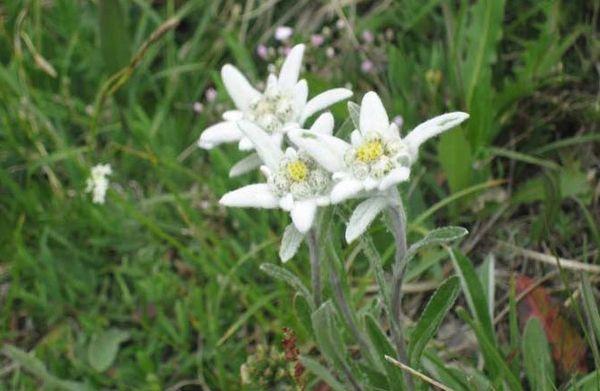

Seeds
You can start sowing seeds for seedlings already at the end of February. The seeds are preliminarily kept in the refrigerator for 2-2.5 months. Then they are sorted out, dry, non-viable, disinfected in a weak solution of potassium permanganate for 15-20 minutes. Planting seeds is done as follows:
- drainage from small stones or expanded clay is poured at the bottom of the planting box;
- a substrate consisting of leafy earth and sand is poured;
- shallow grooves are made into which seeds are planted, covered with soil;
- plantings are sprayed with water from a spray bottle;
- the box is covered with glass or plastic wrap.
Seedlings will appear in about 2 weeks. Every day you need to ventilate the container and wipe condensation from the covering material. In early June, young plants are planted in a permanent place. Alpine edelweiss will bloom in 2 years.
By dividing the bush
Overgrown bushes are propagated in this way. To do this, the bush is carefully dug out, trying to injure the roots as little as possible. With a sharp knife, edelweiss is divided into 2-3 parts. Each of the divisions should have several growth points.
The procedure is carried out in spring or autumn. Bushes are planted at a distance of 15-20 centimeters from each other. The separated plants bloom next year.
See also
Description of the marsh marigold variety, planting and care featuresRead
By cuttings
Propagated by cuttings alpine edelweiss in June. To do this, use the tops of last year's shoots. The substrate for seedlings is selected from sand, leafy earth with the addition of lime.
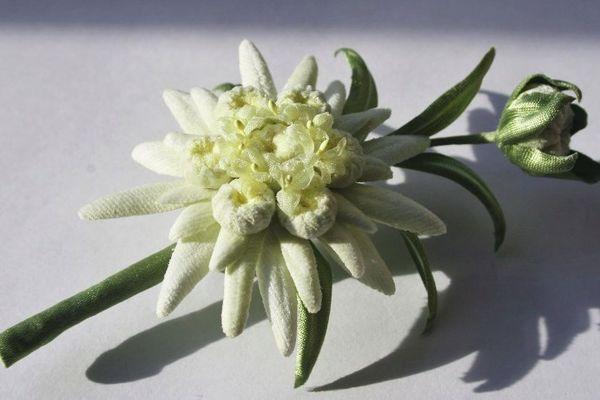

Cuttings are planted as follows:
- cut off parts of shoots are powdered in a preparation that stimulates root formation;
- at a distance of 10-15 centimeters, cuttings are planted in damp ground;
- cover the plantings with jars to retain moisture in them.
Seedlings are watered as needed. When they start to grow, the banks are removed. Blooming will come next season.
Important! Vegetative reproduction allows you to preserve the external features of the species.
Varieties and varieties
The genus of edelweiss includes more than 30 species of this plant. They are very similar to each other. The most common types are:
Alpine
This is the most common type of edelweiss. Its height in gardeners' plots varies from 10 to 20 centimeters. Inflorescences of mountain edelweiss consist of scutes collected in baskets. The leaves around them seem as if they are painted white due to the thick tomentose pubescence. To preserve the characteristics of the species, it must be propagated vegetatively.
See also
Description and characteristics of varieties of petunias, classification of species and colorsRead
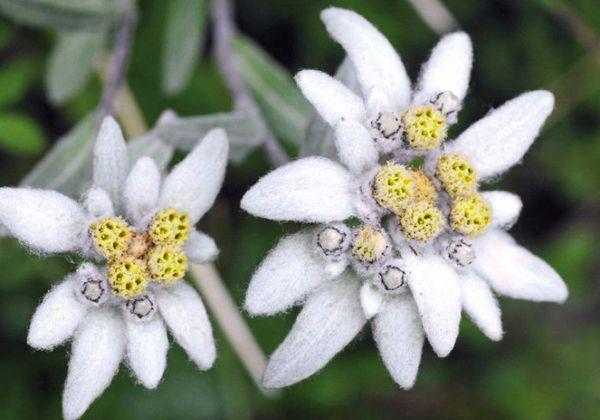

Bicolor
Bushes of two-colored edelweiss consist of erect shoots. They reach a height of 35 centimeters. White and yellow flowers, framed by leaf arrows of various lengths, bloom in July.
Kuril
This is a stunted species of edelweiss. Its length barely reaches 20 centimeters. Basal leaves are oblong, about 7 centimeters long. Stem leaf plates are smaller, felt, gray in color. The bracts, forming a star, are covered with white or yellow felt. Yellow funnel-shaped flowers bloom in late July - early August.
Additional Information. Edelweiss is considered a symbol of Switzerland. The inhabitants of this country call him the queen of the Alps.
What conditions does edelweiss need for successful growth?
For the successful growth of edelweiss, certain conditions must be observed. All these factors, of course, depend on the climatic zone in which it will be grown.
Interesting fact! Edelweiss is a flower of love. Having presented it to his beloved, the young man confessed his eternal love for the girl.
Does edelweiss need the sun, how to choose lighting for a flower
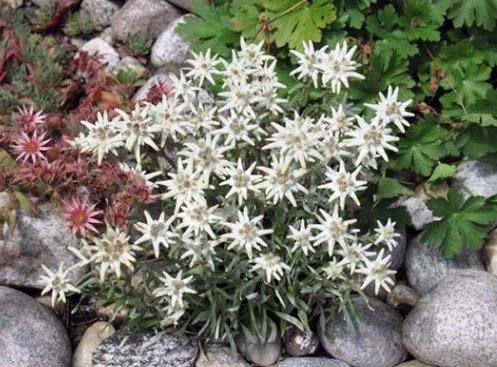

For the successful growth of edelweiss, it is necessary to choose a well-lit place. Areas on which there is no stagnation of water on a hill are recommended. But at the same time, edelweiss can easily grow in partial shade. It would be nice to choose an area for him in which the sun will illuminate the plant until lunchtime, and in the afternoon it will make a slight partial shade.
What should be the soil for edelweiss
For planting edelweiss, light, loose sandy soil is suitable, which can easily pass water. The soil should be well dried, with an admixture of gravel or coarse sand. Also, lime must be added to the ground.
Important! Do not mix the soil for planting edelweiss with manure.

